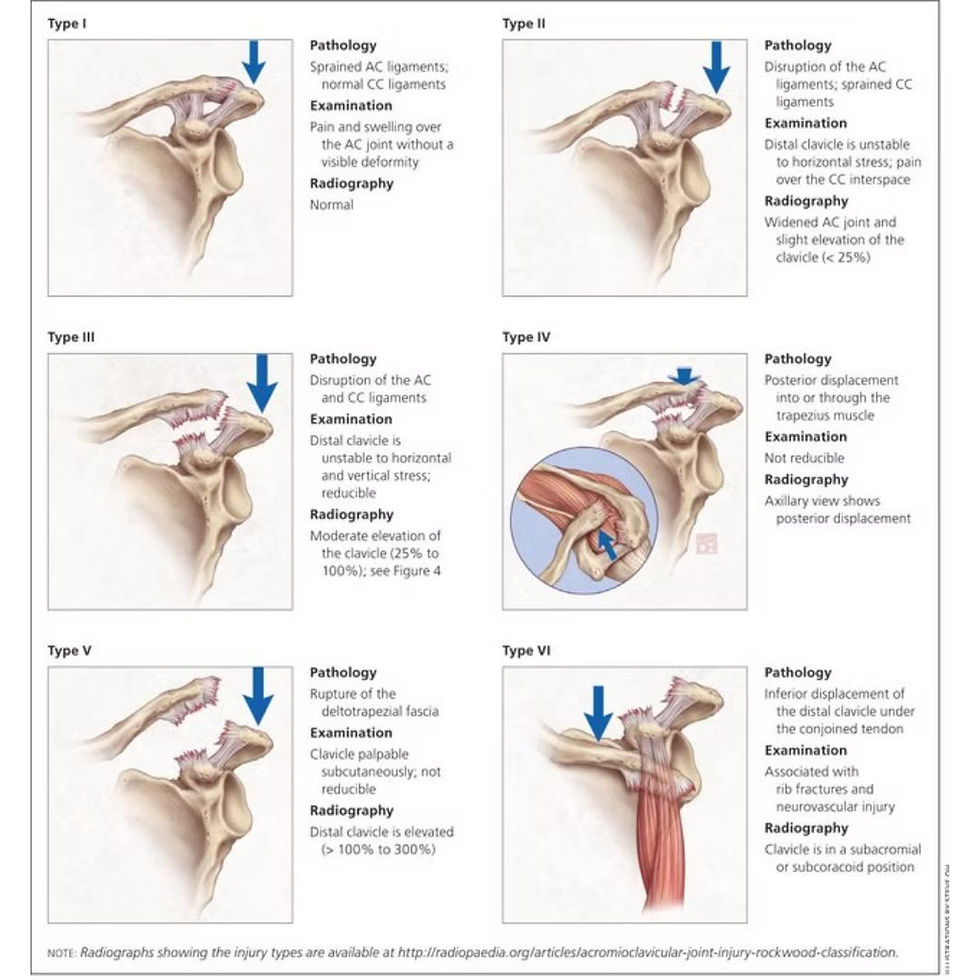
Upper Limb
Acromioclavicular joint (AC) injury
What is Achilles Tendinopathy?
An acromioclavicular joint injury, otherwise known as a shoulder separation, is a traumatic injury to the acromioclavicular (AC) joint with disruption of the acromioclavicular ligaments and/or coracoclavicular (CC) ligaments. Those ligaments are part of the static stabilisers of the joint. In this injury the clavicle (collarbone) separates from the scapula (shoulder blade).

Different grades of AC injuries?
Grade I – A slight displacement of the joint. The acromioclavicular ligament may be stretched or partially torn.
Grade II – A partial dislocation of the joint. The acromioclavicular ligament is completely torn, while the coracoclavicular ligaments remain intact
Grade III – A complete separation of the joint. The acromioclavicular ligament, coracoclavicular ligaments and the capsule are torn.
Grades IV to VI – They are all treated surgically because of the severe disruption of all the ligamentous support for the arm and shoulder. They are very uncommon and are usually the result of a very high-energy injury such as that might occur in a motor vehicle accident.
Common signs and symptoms:
Pain
Limited range of motion in the shoulder
Swelling
Bruising
Tenderness at the top of the shoulder
You may be able to see that the collarbone is out of place or notice a bump on the shoulder
Common causes:
Acromioclavicular joint injuries account for 40-50% of athletic shoulder injuries. More commonly seen in males and athletes.Injury happens when:
Falling onto an outstretched hand or elbow
Direct blows to the shoulder
Falling onto the tip of the shoulder
Injury is frequently seen in hockey and rugby players, but is also seen in snowboarding, skiing, cycling and motor vehicle accidents.
Prognosis:
Type I and II injuries usually have good to excellent results with return to full function in 1-3 weeks
Type III injuries usually return to full function in 6-12 weeks if non-operative
Type IV, V and VI generally require surgery and return to play depends on healing and restoration of near normal strength and range of motion.
Treatment options:
The main goals of treatment for an AC joint injury are to manage pain and improve shoulder range of movement and strengthen muscles in and around your shoulders.
Grade I – III (Conservative management)
The main goals of treatment for an AC joint injury are to manage pain and improve shoulder range of movement and strengthen muscles in and around your shoulders.
Phase I
Goals: Pain management
Icing of the shoulder
Immobilisation of shoulder in a sling for 1-2 weeks
Consumption of pain medications as needed
Gentle passive range of movement
Phase 2
Goals: Increase range of movement and strengthening of the muscles around the shoulder and shoulder blades
Static shoulder strengthening exercises and progression to strengthening exercises with TheraBand
Shoulder mobilisation exercises
Strengthening of the muscles around shoulder blade
Phase 3
Goals: Progression towards functional and sporting activities and retraining of proprioception which is the body’s awareness of where a limb is in space. This is important to reduce the likelihood of re dislocation.
Progression of strengthening exercises through greater range
Progression of strengthening muscles around the shoulder blade in arms in over-head positions
Weight bearing exercises
Note: Grade III may be managed conservatively, however surgery may also be indicated based on the severity of the symptoms. Overhead workers and athletes often require surgery.
Grade IV - VI (Conservative management)
Grade IV – VI injuries usually require surgical intervention to restore shoulder function.

